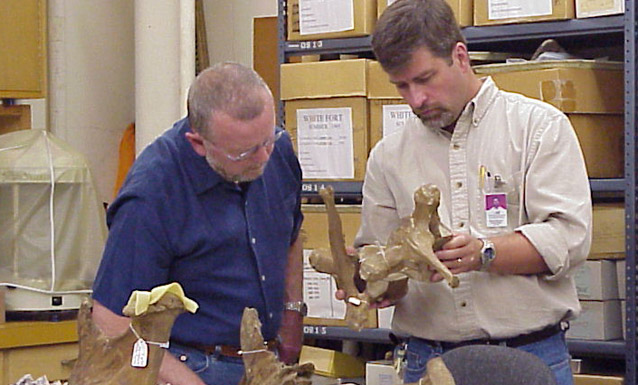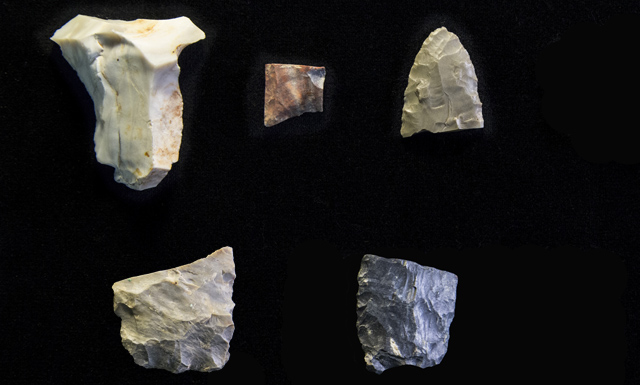By John Mangels
Science Communications Officer
The mystery of the Hartley mastodon’s missing bones hasn’t been solved yet.
But a small trove of ancient stone hunting tools unearthed near where the extinct elephant cousin’s legless skeleton was found 16 years ago in an eastern Ohio bog provides circumstantial evidence about the animal’s fate.
The tools also offer valuable new insights about the prehistoric Native Americans known as Paleoindians who spent time in the area’s wildlife-rich forests and wetlands beginning 13,000 years ago.
“We don’t have direct evidence. We don’t have a smoking gun,” said Cleveland Museum of Natural History Curator of Archeology
Brian Redmond, Ph.D., a co-author of a recent
study analyzing the five stone tools, which were recently donated to the Museum. But the artifacts’ presence in the same locale as the mastodon’s strangely incomplete remains “makes the site much more of an interesting scientific location for further review.”
The study was led by Kent State University anthropologists Michelle Bebber and
Metin Eren, Ph.D., and included a team of specialists.
The Bones’ Tale
The mastodon mystery began on July 28, 2001. Burton Hartley, a commercial excavator, was digging a farm pond on the site of an old bog in Columbiana County.
As Hartley’s backhoe bucket scooped up the damp, spongy soil, it exposed the mastodon’s skull. During the next several weeks, Kent State University geology instructor Cheryl Mattevi and volunteers recovered numerous pieces of the skeleton from the mud, carefully mapping and photographing their locations.
In the late Ice Age, when the bog was a shallow glacial lake, it would have been a natural gathering place for mastodon and other woodland dwellers, including a deer-like moose called
Cervalces and hulking, short-faced bears bigger than today’s grizzlies.
The Museum decided to buy the mastodon’s remains for its research collection and to allow scientific analysis. When Dr. Redmond and then-Curator of Vertebrate Paleontology Michael Williams, Ph.D., inventoried the 95 bones recovered from the bog, they saw that virtually every piece of the mastodon was present: its skull, jaws and teeth; its distinctive, curving tusks; 36 ribs; 29 vertebrae; 20 foot bones; and even a piece of the fragile hyoid bone from its throat.
 In 2001, then-Curator of Vertebrate Paleontology Dr. Michael Williams and Curator of Archaeology Dr. Brian Redmond examine the bones of the Hartley Mastodon.
In 2001, then-Curator of Vertebrate Paleontology Dr. Michael Williams and Curator of Archaeology Dr. Brian Redmond examine the bones of the Hartley Mastodon.
Curiously, though, the mastodon’s leg bones, shoulder blades and breast bone were missing.
The foot bones and several ribs appeared to have been chewed on by a scavenging animal, possibly a wolf or other carnivore. But each of the absent leg bones would have been too big and heavy for most scavenging animals to tear loose from the carcass and drag away.
Two of the mastodon’s back bones, or vertebrae, showed some damage that indicated the spinal column may have been forcefully separated into pieces. How that might have happened wasn’t clear. There were no obvious cut marks on any of the bones that might have indicated the animal was butchered, and no stone tools were found at the bog site during the 2001 excavation.
Distinctive Tools
But in the nearly two decades since the dig, farm owner Donna Jackson collected a variety of ancient artifacts brought to the surface during plowing.
From that collection, Drs. Redmond and Eren identified five stone tools found in a field about half a mile from the mastodon site that were worthy of further study. Ms. Jackson donated them to the Museum, and the researchers acknowledged her contribution by including her as a coauthor on the study.
 Jackson Farm owner Donna Jackson shows a collection of ancient artifacts found on her property.
Jackson Farm owner Donna Jackson shows a collection of ancient artifacts found on her property.
“Landowners across Ohio have been extremely cooperative and helpful” in allowing archaeological research on their properties, Dr. Redmond said. “Working with private individuals is really important for preserving these sites and learning more about Ohio’s prehistory.”
The design of the five tools from the Jackson farm indicated that they were produced by Paleo-Indians from the Clovis culture, which occupied Ohio during the same time period as when the mastodon died. (Radiocarbon dating using two pieces of the animal’s rib put its age at about 11,000 years before the present time.)
 These are the five stone tools found near the Hartley Mastodon. The fire-scorched spear point is the reddish stone in the middle of the upper row.
These are the five stone tools found near the Hartley Mastodon. The fire-scorched spear point is the reddish stone in the middle of the upper row.
The most distinctive of the tools was the broken base of a Clovis spear point. A groove on one side allowed it to be tied to a wooden shaft with a piece of sinew or plant fiber. The tool was scorched in a fire so hot it caused the stone to change color from bone white to brick red. The heating was possibly an effort by the toolmaker to free the broken spear point base from its shaft so it could be replaced.
“You stick it in the fire and the wrappings burn away and you can get the base off,” said Dr. Eren, who has experience making stone tools that mimic Paleo-Indian designs.
The other four tools found in the field near the mastodon site were a broken spear tip; the broken midsection of another sharpened projectile point; the broken, unfinished base (called a preform) of what may have been intended to be a fluted point; and an unformed flint flake chipped from a larger stone and ready to be made into a knife or animal hide-scraper.
A Closer Look
Microscopic examination of the five tools by Illinois State University anthropologist Logan Miller, Ph.D., showed that the spear tip’s edges had greasy polish marks — an indication that it was used to butcher meat. The spear tip, the broken midsection, the preform and the flake all had wear marks suggesting that they were jostled and rubbed against each other while being carried inside a pouch, probably made of animal hide. Only the broken spear base showed no evidence of having been used.
The tools were made from four different types of flint, quarried from geologic deposits as far as 500 miles away in southern Indiana, and from several Ohio sites — consistent with the northeastward Clovis migration from central to northern Ohio.
The raw material for the preform tool was Plum Run flint, which not only occurs in a primary geologic deposit eight miles from the mastodon site but also exists in chunks of stone that litter the Jackson Farm fields. The rock was scooped up and dumped there tens of thousands of years ago by a retreating glacier. A Clovis toolmaker may have smashed the preform from one of those handy chunks rather than traveling to the quarry.
A Multipurpose Site
Taken together, the evidence shows that a variety of Paleo-Indian activities took place at the Jackson farm site, from discarding used and broken tools to making new ones, possibly utilizing a controlled fire or a hearth.

“They would have been bringing finished or proto artifacts in, and utilizing this local material to replace tools that were worn out or to make news tools to take with them,” Dr. Redmond said. “So in one way, it’s a workshop site … but it could also be a stopover for hunting and gathering.”
In that sense, it could be similar to Paleo Crossing, a significant Paleo-Indian base camp in Medina County where Museum excavations have recovered hundreds of stone tools and identified signs of extended habitation.
For now, there is no direct connection linking the five Jackson Farm artifacts and the Hartley mastodon’s remains. Their proximity could be mere coincidence.
Only 15 sites in North America have produced compelling signs that humans killed and butchered Ice Age mammals. Could the Jackson Farm be the 16
th? More evidence is needed.
The discovery of tools “adds another dimension to that locality,” Dr. Redmond said. “To me, there’s still the possibility that the toolmakers somehow interacted with the mastodon. Or maybe someone interacted with the mastodon 50 years before, and this group comes back and explores a bigger area. But it makes it a more significant place. This isn’t just a site. It’s a complex. Maybe eventually, if we’re really lucky, we’ll find something that might tie the Paleo-Indian occupation to the Hartley mastodon.”
Science writer John Mangels is The Cleveland Museum of Natural History’s science communications officer. Contact him at [email protected].
Go back to all blogs